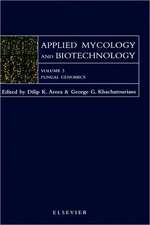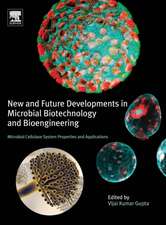Biotechnology and Biology of Trichoderma
Editat de Vijai G. Gupta, Monika Schmoll, Alfredo Herrera-Estrella, Dr. R. S. Upadhyay, Irina Druzhinina, Maria Tuohyen Limba Engleză Hardback – 27 feb 2014
- Provides a detailed and comprehensive coverage of the chemistry, biochemistry and biotechnology of Trichoderma, fungi present in soil and plants
- Includes most important current and potential applications of Trichoderma in bioengineering, bioprocess technology including bioenergy & biofuels, biopharmaceuticals, secondary metabolites and protein engineering
- Includes the most recent research advancements made on Trichoderma applications in plant biotechnology and ecology and environment
Preț: 885.79 lei
Preț vechi: 1227.53 lei
-28% Nou
Puncte Express: 1329
Preț estimativ în valută:
169.49€ • 177.44$ • 140.25£
169.49€ • 177.44$ • 140.25£
Carte tipărită la comandă
Livrare economică 29 martie-12 aprilie
Preluare comenzi: 021 569.72.76
Specificații
ISBN-13: 9780444595768
ISBN-10: 0444595767
Pagini: 650
Ilustrații: 50 illustrations
Dimensiuni: 216 x 276 x 32 mm
Greutate: 1.59 kg
Editura: ELSEVIER SCIENCE
ISBN-10: 0444595767
Pagini: 650
Ilustrații: 50 illustrations
Dimensiuni: 216 x 276 x 32 mm
Greutate: 1.59 kg
Editura: ELSEVIER SCIENCE
Public țintă
Professionals, researchers, undergraduates, or post-graduates in bio-chemical engineering and biochemistry/biology; evolution and genetics researchersCuprins
1. Applications of Trichoderma in biofuel industry: An overview
2. Cellulase systems in Trichoderma: An overview
3. Industrial use and improvement of Trichoderma cellulases in the 21st century
4. Development of Trichoderma enzyme systems for saccharification of lignocellulosic feedstock
5. Beta-glucosidase from Trichoderma to improve the activity of enzymatic cocktails
6. Genetic engineering/ Molecular mechanism of cellulase production systems in Trichoderma/ Molecular mechanism of cellulase production systems in Trichoderma
7. Applications of RNA interference for enhanced cellulase production in Trichoderma.
8. Biosynthesis of silver nano-particles by Trichoderma spp./ Trichoderma silver nano-particles in medical applications
9. Trichoderma enzymes for food industries
10. Trichoderma: A dual function fungi and their use in the wine and beer industries
11. Trichoderma enzymes for fabric/textile industries
12. Role of Trichoderma species in bioremediation process: Biosorption studies on hexavalent chromium
13. Molecular evolution of Trichoderma chitinases/ Chitinase genes from native isolates of Trichoderma spp
14. Molecular mechanisms and applications of biocontrol in agriculture
15. Applications of Trichoderma in plant growth promotion
16. Enhanced resistance of plants to abiotic stresses with the use of Trichoderma
17. Enhanced Resistance of Plants to Diseases using Trichoderma spp
18. Genes from Trichoderma as a source for improving plant resistance to fungal pathogen
19. Genome-wide approaches towards understanding mycotrophic Trichoderma species
20. Advances in formulation of Trichoderma for biocontrol
21. Trichoderma: A silent worker of plant rhizosphere
22. Signal transduction in mycoparasitic Trichoderma: Involvement of signaling cascades in regulating the mycoparasitic host attack and plant interaction
23. Enhanced plant immunity using Trichoderma
24. Secondary metabolism of Trichoderma/Antimicrobial metabolites of Trichoderma
25. Metabolic diversity of Trichoderma
26. Recent advancements on the role and analysis of volatile compounds (VOCs) from Trichoderma
27. Heterologous expression of proteins in Trichoderma
28. Regulation of protein secretion in Trichoderma
29. Trichoderma reesei secretome: An overview
30. Trichoderma protein with disruption activity on cellulosic substrates
31. Sequence analysis of industrially important genes from Trichoderma species
32. Tools for strain improvement of Trichoderma spp
33. Transcriptional regulation of glycoside hydrolases in Trichoderma
34. Multilocus phylogenetic structure within the Trichoderma - recent updates/ Molecular taxonomy of Trichoderma: Current advancements/Species diversity of Trichoderma
35. Ecophysiology of Trichoderma in genomic perspective
(Continued)
2. Cellulase systems in Trichoderma: An overview
3. Industrial use and improvement of Trichoderma cellulases in the 21st century
4. Development of Trichoderma enzyme systems for saccharification of lignocellulosic feedstock
5. Beta-glucosidase from Trichoderma to improve the activity of enzymatic cocktails
6. Genetic engineering/ Molecular mechanism of cellulase production systems in Trichoderma/ Molecular mechanism of cellulase production systems in Trichoderma
7. Applications of RNA interference for enhanced cellulase production in Trichoderma.
8. Biosynthesis of silver nano-particles by Trichoderma spp./ Trichoderma silver nano-particles in medical applications
9. Trichoderma enzymes for food industries
10. Trichoderma: A dual function fungi and their use in the wine and beer industries
11. Trichoderma enzymes for fabric/textile industries
12. Role of Trichoderma species in bioremediation process: Biosorption studies on hexavalent chromium
13. Molecular evolution of Trichoderma chitinases/ Chitinase genes from native isolates of Trichoderma spp
14. Molecular mechanisms and applications of biocontrol in agriculture
15. Applications of Trichoderma in plant growth promotion
16. Enhanced resistance of plants to abiotic stresses with the use of Trichoderma
17. Enhanced Resistance of Plants to Diseases using Trichoderma spp
18. Genes from Trichoderma as a source for improving plant resistance to fungal pathogen
19. Genome-wide approaches towards understanding mycotrophic Trichoderma species
20. Advances in formulation of Trichoderma for biocontrol
21. Trichoderma: A silent worker of plant rhizosphere
22. Signal transduction in mycoparasitic Trichoderma: Involvement of signaling cascades in regulating the mycoparasitic host attack and plant interaction
23. Enhanced plant immunity using Trichoderma
24. Secondary metabolism of Trichoderma/Antimicrobial metabolites of Trichoderma
25. Metabolic diversity of Trichoderma
26. Recent advancements on the role and analysis of volatile compounds (VOCs) from Trichoderma
27. Heterologous expression of proteins in Trichoderma
28. Regulation of protein secretion in Trichoderma
29. Trichoderma reesei secretome: An overview
30. Trichoderma protein with disruption activity on cellulosic substrates
31. Sequence analysis of industrially important genes from Trichoderma species
32. Tools for strain improvement of Trichoderma spp
33. Transcriptional regulation of glycoside hydrolases in Trichoderma
34. Multilocus phylogenetic structure within the Trichoderma - recent updates/ Molecular taxonomy of Trichoderma: Current advancements/Species diversity of Trichoderma
35. Ecophysiology of Trichoderma in genomic perspective
(Continued)

























